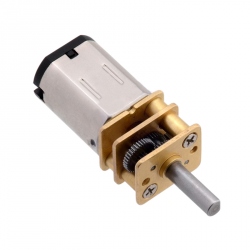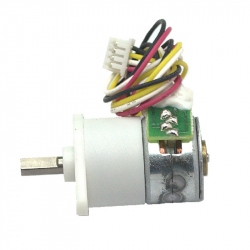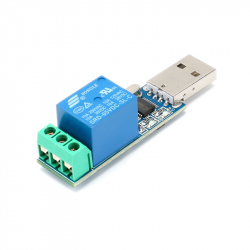Dupa plasarea solicitării de comandă, in sectiunea Istoric puteti vedea cate solicitări de comandă mai avem de procesat inaintea dumneavoastra
Program de lucru: Luni - Vineri 9:00 - 18:00, pauza 13:00 - 14:00.
Se efectueaza lucrari de mentenanta la site si pot aparea erori. In cazul in care intampinati erori va rugam sa reincercati mai tarziu.
Ridicarea personala este disponibila pentru comenzile achitate in avans. Se pot ridica dupa ce sunt pregatite.
No products
 View larger
View larger
Zumo Chassis Kit (No Motors)
0104110000010148
New product
The Pololu Zumo chassis is a small, tracked robot platform that is less than 10 cm on each side, allowing it to qualify for Mini Sumo competitions. The chassis is composed of black ABS and features a compartment for four AA batteries and sockets for two micro metal gearmotors. It ships as a kit with two silicone tracks, two drive and two idler sprockets, a 1/16" acrylic mounting plate, and mounting hardware. (Motors and batteries are not included.)
See description for more details about the product.
Add to cart now!
This product is no longer in stock
- Write a review
- Remove this product from my favorite's list.
- Add this product to my list of favorites.
More info
Overview
The Zumo chassis kit contains the components necessary to build a small, high-performance tracked robot platform that is compact enough to qualify for Mini Sumo competitions. The chassis is made from black ABS plastic and has sockets for two micro metal gearmotors and a compartment for four AA batteries (motors and batteries are not included). The battery compartment terminals protrude through the chassis and can be accessed from the top side. A black acrylic plate is included with the chassis. This plate holds the motors in place and can be used for mounting your electronics, such as your microcontroller, motor drivers, and sensors.

Pololu Zumo chassis kit components.
The drive system consists of two black silicone tracks, one on each side, that are each supported by a freely spinning idler sprocket and a motor-driven drive sprocket (see the Motors section below for more information on how to select appropriate motors for your robot). These tracks are also available separately in two different lengths and three different sprocket colors.

Motors (not included)
The Zumo chassis uses two motors, one for each tread. The ideal motors for your robot depend on your desired torque, speed, and current draw, so motors are not included with the chassis. We generally recommend using high-power (HP or HPCB, which have long-life carbon brushes) versions of our micro metal gearmotors since the tracks require a decent amount of torque to move effectively; higher gear ratios of the non-HP motors might work if you want lower current draw, but they will be slower and offer less control. Specifically, we primarily recommend the 50:1, 75:1, or 100:1 HP or HPCB motors for use with this chassis. The following table summarizes the key specifications of these three gearmotors. The first four columns are specifications of the motors themselves, while the last column is the measured top speed of a Zumo chassis loaded to a weight of 500 g and driven with these motors. Note that the specifications are for 6V operation, which is approximately the voltage you would get with four alkaline batteries; four NiMH AA cells will typically provide less than 5V.
Electronics (not included)
You can add your own motor drivers, sensors, and programmable controllers to this chassis, or you can get one of our more complete Zumo robots, which include electronics designed specifically for the Zumo chassis.

A Zumo 32U4 robot (left) and a Zumo robot for Arduino with an A-Star 32U4 Prime LV (right).
The Zumo Robot for Arduino combines a Zumo chassis with a Zumo shield, which includes a dual motor driver, buzzer, and three-axis accelerometer and compass, giving you all the basic mechanical parts and electronics to build an Arduino-controllable robot (Arduino not included). The newer Zumo 32U4 Robot is a more highly integrated robot also based on the Zumo chassis that includes an Arduino-compatible ATmega32U4 microcontroller and even more sensors (quadrature encoders and a proximity sensor system).
If your goal is to make a robot based around a controller other than an Arduino, we recommend the DRV8833 motor driver carrier or qik 2s9v1 for use with this chassis.

Batteries (not included)
The Zumo chassis uses two motors, one for each tread. The ideal motors for your robot depend on your desired torque, speed, and current draw, so motors are not included with the chassis. We generally recommend using high-power (HP or HPCB, which have long-life carbon brushes) versions of our micro metal gearmotors since the tracks require a decent amount of torque to move effectively; higher gear ratios of the non-HP motors might work if you want lower current draw, but they will be slower and offer less control. Specifically, we primarily recommend the 50:1, 75:1, or 100:1 HP or HPCB motors for use with this chassis. The following table summarizes the key specifications of these three gearmotors. The first four columns are specifications of the motors themselves, while the last column is the measured top speed of a Zumo chassis loaded to a weight of 500 g and driven with these motors. Note that the specifications are for 6V operation, which is approximately the voltage you would get with four alkaline batteries; four NiMH AA cells will typically provide less than 5V.
Basic sumo blade (not included).
We carry a basic stainless steel sumo blade that can be mounted to front of the Zumo chassis. With this blade, the Zumo chassis can push around objects, such as other MiniSumo robots. You can also use the design file for this basic blade as the starting point for a custom sumo blade.

Basic sumo blade mounted on a Zumo chassis.
Replacement sprockets
The Zumo chassis includes the black sprockets shown in the left picture below, but there are sprockets available in red and white that can be purchased separately if you want to add a bit of personalization to your chassis. Note that the white sprockets are white versions of the new, spoked style, not the older style still visible in some of the other pictures on this page that show white sprockets.
 Zumo 32U4 robot with black sprockets.
Zumo 32U4 robot with black sprockets. Zumo 32U4 robot with black sprockets.
Zumo 32U4 robot with black sprockets. Zumo 32U4 robot with black sprockets.
Zumo 32U4 robot with black sprockets.
Dimensions
Fully assembled, the Zumo chassis is 98 mm wide, 86 mm long, and 39 mm high, with approximately 5 mm of ground clearance.

Pololu Zumo chassis, assembled top view with dimensions, shown with motors.

Pololu Zumo chassis, assembled top view with dimensions, shown with motors.
Since each side is smaller than 10 cm, this chassis meets Mini-Sumo size requirements. The front screws used to mount the acrylic plate to the chassis can also be used to mount a front scoop that can extend up to 14 mm before exceeding the Mini Sumo limits. The assembled Zumo chassis weighs approximately 210 g with motors and batteries.

Example robot based on the Pololu Zumo chassis next to a Parallax SumoBot.
Specifications
Dimensions
| Size: | 98 x 86 x 39 mm |
| Weight: | 7.5 oz1 |
Notes:
1 With motors and batteries; weighs 3.0 oz as shipped, without motors or batteries.
Don't delay. Buy today.
Add to cart now!
Reviews
Accessories
Customers who bought this product also bought:
-

250:1 Micro...
This gearmotor is a miniature high-power, 6 V...
$33.84
-

HC-05 Master...
The HC-05 Bluetooth module is a high...
$6.74
-

5 V Active...
This buzzer can be connected to the standard...
$0.34
-

Board...
Board Compatible with Arduino Nano (ATmega328p...
$7.05
-

GM12-15BYC...
GM12-15BYC Micro Gear Stepper Motor (1:100)...
$11.76
-

Mini Maestro...
The 18-channel Mini Maestro 18 raises the...
$48.00
-

USB 5V 10A...
USB 5V 10A Relay Module
$9.60
-

433 MHz...
433 MHz Receiver Transmitter Pair See...
$1.56
-

Cutter...
Cutter See description for more details about...
$1.04
-

GA12-N20...
This small and light, yet powerful geared motor...
$6.60











